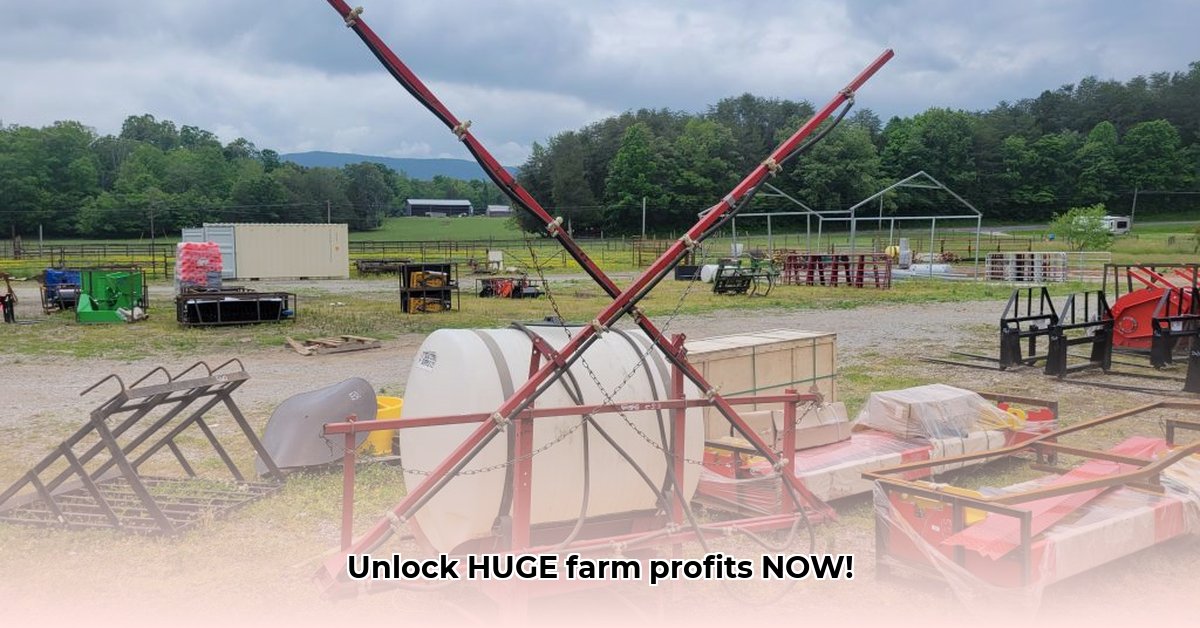
Choosing the Right Boom Sprayer for Sustainable Agriculture
Precision spraying with boom sprayers offers a powerful pathway to sustainable and profitable farming. By precisely applying pesticides and herbicides, farmers can reduce chemical usage, minimize environmental impact, and enhance crop yields. This guide helps you navigate the options available at your local tractor supply to select and utilize a boom sprayer effectively. For maintaining your farm equipment, consider exploring tractor attachments.
Understanding Your Farm's Needs: A Personalized Approach
Selecting the ideal boom sprayer is a tailored process, much like choosing the right tool for a specific job. Several key factors must be considered:
Farm Size: Small farms typically require maneuverable sprayers with smaller tanks, while large operations need high-capacity models with wider booms to cover extensive acreage efficiently.
Crop Type: Different crops have unique spraying requirements. Row crops, like corn and soybeans, need different nozzle configurations compared to sprawling crops such as alfalfa or wheat. Consider adjustable boom widths and various nozzle types to ensure optimal application for your specific crops.
Terrain: Uneven terrain demands sprayers designed for stability and ease of operation on slopes and rough surfaces. Stability is crucial to prevent spills and ensure even coverage, maximizing the effectiveness of your application.
Budget: Boom sprayer costs vary significantly, impacting the overall investment. Factor in not only the initial purchase price but also the long-term expenses associated with maintenance, fuel consumption, and potential repairs. Prioritize fuel efficiency to reduce operational costs over time.
Technological Advancements: GPS guidance, auto-shutoff, and other smart features enhance precision, reduce chemical waste, and optimize spraying efficiency. While these add to upfront costs, the long-term benefits of reduced waste and increased accuracy often justify the investment.
Boom Sprayer Types: A Detailed Comparison
Several boom sprayer types cater to different farm sizes and operational needs. Each type presents distinct advantages and disadvantages:
| Boom Sprayer Type | Advantages | Disadvantages | Best Suited For |
|---|---|---|---|
| Self-Propelled | Excellent maneuverability, independent of tractor, precise application | Higher initial investment, more complex maintenance | Large, uneven fields; precise application needed; efficient coverage |
| Tractor-Mounted | Lower initial cost, utilizes existing tractor equipment | Less maneuverable, relies on tractor's power, limited maneuverability | Smaller to medium-sized farms; relatively flat land |
| Large Field Sprayers | High capacity, very efficient for vast areas | Requires substantial power, high initial cost, specialized maintenance | Very large-scale operations; uniform terrain |
| Smaller, Compact Sprayers | Easy maneuverability, ideal for smaller fields, specialized applications | Limited capacity, may be less efficient for large areas | Smaller farms; specialized applications; orchards; uneven terrain |
Choosing the appropriate type aligns directly with your farm's unique characteristics and operational demands.
Calibrating Your Sprayer for Precision Application
Accurate calibration is paramount for efficient and economical spraying. Inaccurate calibration wastes chemicals, increases costs, and potentially harms the environment. Follow these steps:
Measure Output: Run the sprayer (with water) for a set time (e.g., 1 minute) and precisely measure the dispensed liquid volume.
Calculate Spray Rate: Use the measured volume to determine the liquid sprayed per acre, ensuring consistent application across your fields. Consult your equipment manual or online resources for precise calculation methods relevant to your equipment and field conditions.
Adjust Nozzles: Modify nozzle settings to achieve the desired spray rate. This may involve adjusting pressure or changing nozzle types based on the manufacturer's recommendations.
Test and Refine: Conduct a test run on a small area to assess coverage uniformity. Refine settings until consistent coverage is achieved. Uneven application indicates further calibration adjustments are necessary.
Boom Sprayer Maintenance: Protecting Your Investment
Regular maintenance significantly extends the lifespan of your boom sprayer and ensures optimal performance. It prevents costly repairs and down time.
Regular Cleaning: Thoroughly clean the boom and nozzles after each use to prevent clogs and maintain even spraying. Remove any dried residue or debris to avoid clogging nozzles and ensure consistent application.
Nozzle Inspection: Inspect nozzles for wear and promptly replace any damaged or worn components. This preserves spray accuracy and prevents uneven application.
Hose and Fitting Checks: Regularly examine hoses and fittings for cracks, leaks, or looseness. Repair or replace damaged components to prevent spills and maintain system integrity.
Lubrication: Keep moving parts well-lubricated to minimize friction and extend sprayer longevity.
Sustainable Spraying Techniques: Minimizing Environmental Impact
Sustainable farming necessitates responsible pesticide application. Proper techniques minimize environmental impact and optimize resource utilization.
Targeted Spraying: Utilize GPS guidance and auto-shutoff to apply chemicals only where needed, greatly decreasing chemical waste and minimizing environmental harm.
Drift Prevention: Spray on calm days to avoid wind-borne chemical drift, which can damage other plants and contaminate water sources. Consider spray adjuvants to reduce drift further.
Water Conservation: Employ appropriate nozzle types and pressures to minimize water usage without compromising spray quality.
Chemical Selection: Choose effective, environmentally friendly chemicals. Carefully read labels and adhere to application instructions. Prioritize integrated pest management strategies to reduce your reliance on chemical interventions.
Addressing Challenges and Common Problems
Even well-maintained sprayers can encounter issues. Understanding common problems and their solutions is key to efficient operation:
Clogged Nozzles: Regular cleaning prevents clogging, but if it occurs, use a cleaning solution or needle according to the manufacturer’s recommendations to clear the blockage.
Uneven Spray Patterns: Verify calibration and check nozzles for wear or damage. Uneven patterns may indicate issues with nozzle orientation or pressure settings.
Regulatory Compliance: Safe and Legal Pesticide Use
Always comply with all local and federal regulations regarding pesticide application. Familiarize yourself with label instructions, safety precautions, and proper disposal methods to ensure safe and legal operation.
Conclusion: Investing in a Sustainable Future
Investing in a boom sprayer is an investment in your farm’s future. By carefully selecting the right equipment, mastering calibration and maintenance, and employing sustainable spraying practices, you can significantly boost farm profitability while minimizing environmental impact. This integrated approach secures both your farm's financial success and its long-term sustainability.